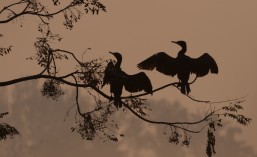This slideshow requires JavaScript.
Order: Cuculiformes Family: Cuculidae Conservation Status: Least Concern
Description:
The Guira Cuckoo is a medium-sized bird, typically 34 to 36 cm in length and weighing 140 to 143 grams. It has an overall shaggy appearance with a white-streaked brown back and wings, white upper tail coverts and lower back. The throat and breast are whitish with fine dark brown streaks. The rest of the underparts are whitish-buff. The tail is blackish with a broad white tip. It has a long orange-rufous crest, orange to yellow eyes and the bare skin on the face is yellow. The strong bill is orange with a yellow base to the lower mandible. The legs and feet are blue-grey.
There is no sexual dimorphism in adults.
Juvenile birds are similar to adults but have white spots on the tip of the flight feathers, pale grey eyes and a black and white bill.
Call and Vocalisation:
The Guira Cuckoo is a noisy bird, especially during the breeding season. Calls vary from a “pio pio.. pr…prrr..prrr” whistle to more guttural calls, high pitched gurgling trills and a ‘creep’ noise. Flocks of Guira Cuckoos will clatter loudly when defending their territory.
In addition, the Guira Cuckoo mimics other bird calls.
Guira Cuckoo call
Guira Cuckoo alarm call
Range and Distribution:
The Guira Cuckoo is resident from the mouth of the Amazon in eastern and southern Brazil, west to Bolivia and Paraguay and south into Uruguay and northern and eastern Argentina.

It is monotypic.
Habitat:
The Guira Cuckoo is found in dry forests, scrub savannahs, temperate grasslands and many open habitats including suburban parks and gardens. It occurs from altitudes of sea-level to 1200 metres.
Diet:
Guira Cuckoos feed on insects, frogs, eggs, small birds and small rodents. They are opportunistic predators, often feeding in flocks of about 20 birds, gathering food on the ground or searching amongst branches.
Breeding:
Guira Cuckoos are communal breeders with a polygynadrous mating structure, ie up to 15 individual birds may be at any given nest site and any male will freely mate with any female. The breeding season occurs mostly during the rainy season, from August to March. Courtship displays involve raising the crest and spreading and raising the tail to display plumage patterns. The nest of the Guira Cuckoo is a large open platform built of sticks situated high in the fork of a tree 2 to 5 metres above the ground. Nests are often reused year on year. Individual females will lay 5 to 7 grey-turquoise eggs, resulting in a total of 20 to 25 eggs within the communal nest. The eggs have white chalky markings which are believed to help adults to identify their own brood. In these communal nests competition between adults is high and many eggs are crushed or ejected from the nest before they hatch. The eggs are incubated for 10 to 15 days. After hatching the first-hatched chicks will often kill later hatchlings to guarantee feeding. Surviving chicks fledge after 15 days, but will leave the nest earlier if it is disturbed. The nest is guarded by at least one adult at all times. Only one quarter of all eggs laid and half of all hatchlings survive the nesting process.
Behaviour:
The Guira Cuckoo is highly gregarious and birds are very social, perching and roosting in contact with each other. They are mostly arboreal, but can frequently be seen on the ground, usually in flocks of between 6 and 20 individuals. The Guira Cuckoo is not a good flyer, often hopping or gliding from one location to another. It is sometimes seen with other related birds such as the Smooth-billed Ani (Crotophaga ani) whose behaviour is similar. The Guira Cuckoo gives off a strong, pungent odour.
Conservation Status:
The Guira Cuckoo is a common resident within its range. This range continues to expand and there are no threats to this species at present.

